人教版七年级英语上册:Unit5 Do you have a soccer ball?Section A 1a-2c优质教案
文档属性
| 名称 | 人教版七年级英语上册:Unit5 Do you have a soccer ball?Section A 1a-2c优质教案 | 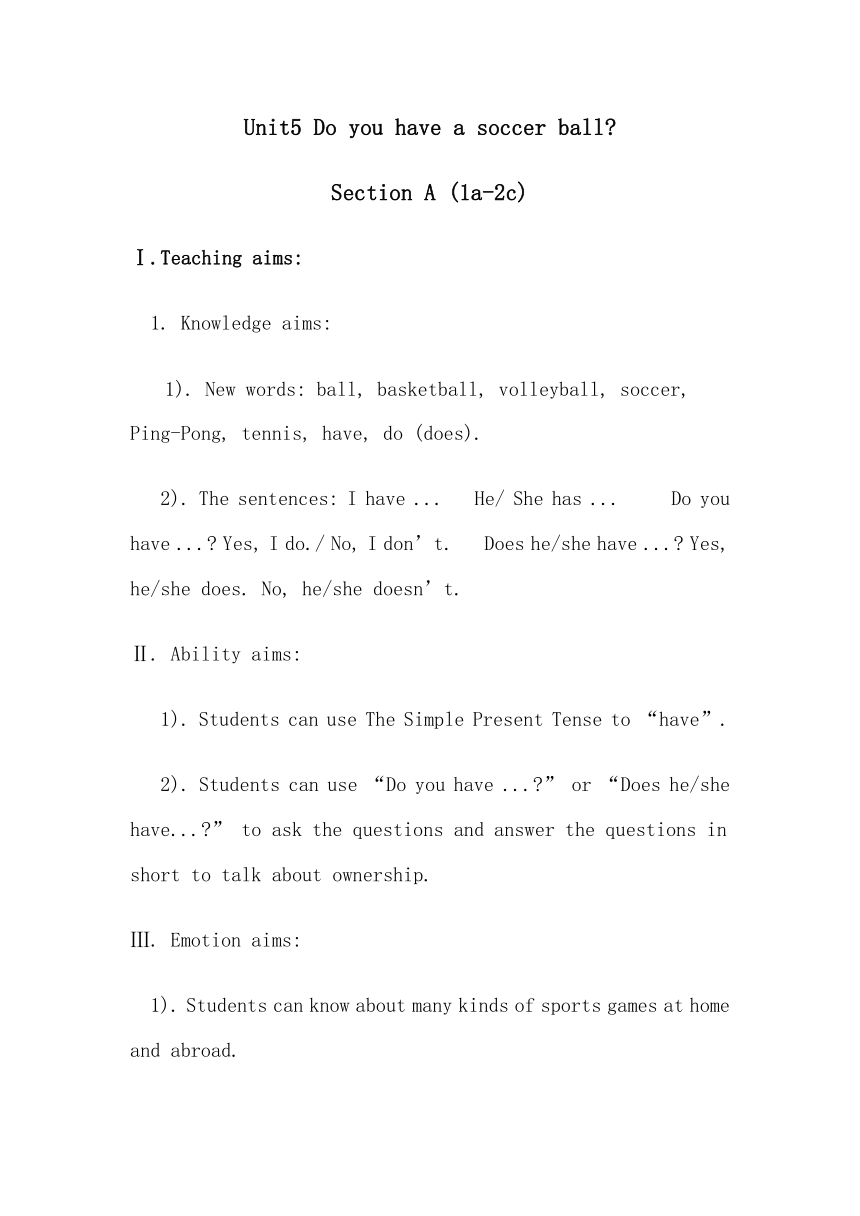 | |
| 格式 | zip | ||
| 文件大小 | 288.3KB | ||
| 资源类型 | 教案 | ||
| 版本资源 | 人教新目标(Go for it)版 | ||
| 科目 | 英语 | ||
| 更新时间 | 2017-01-07 16:51:57 | ||
图片预览

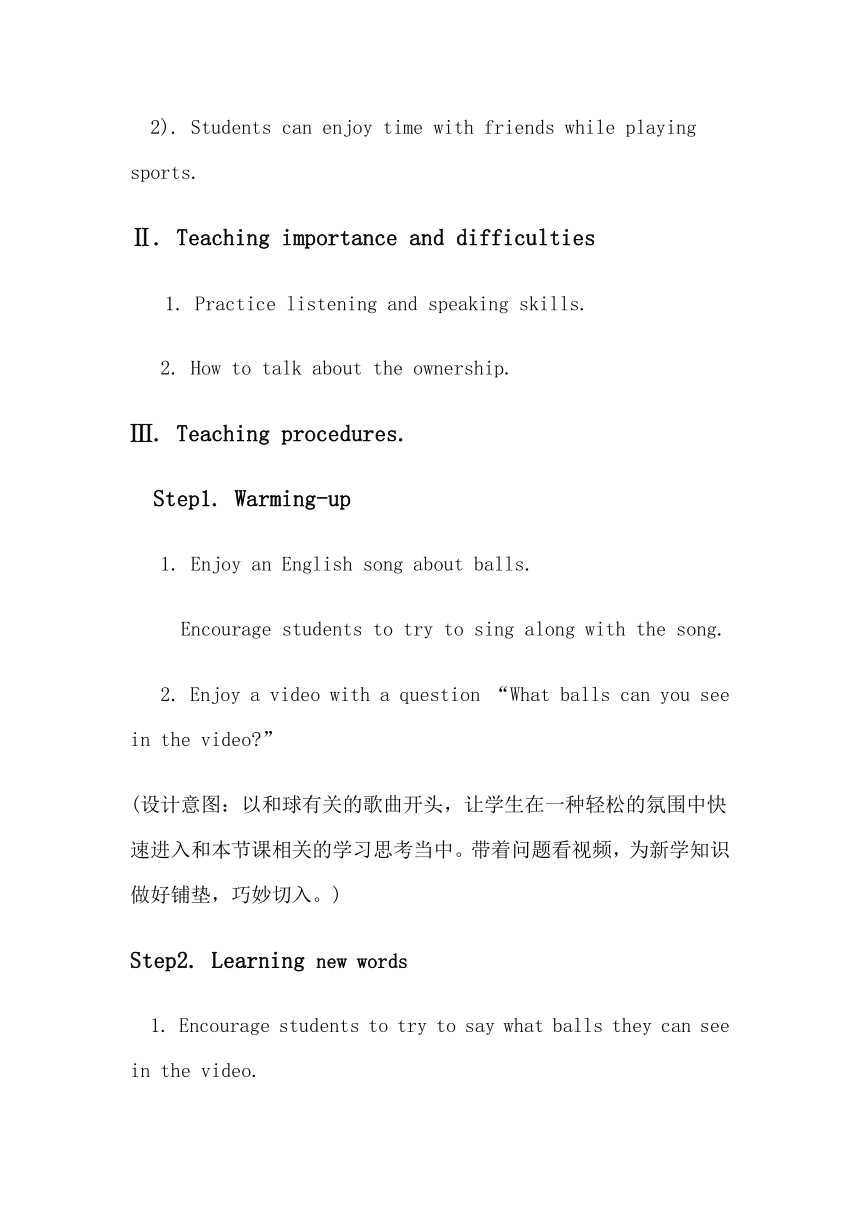
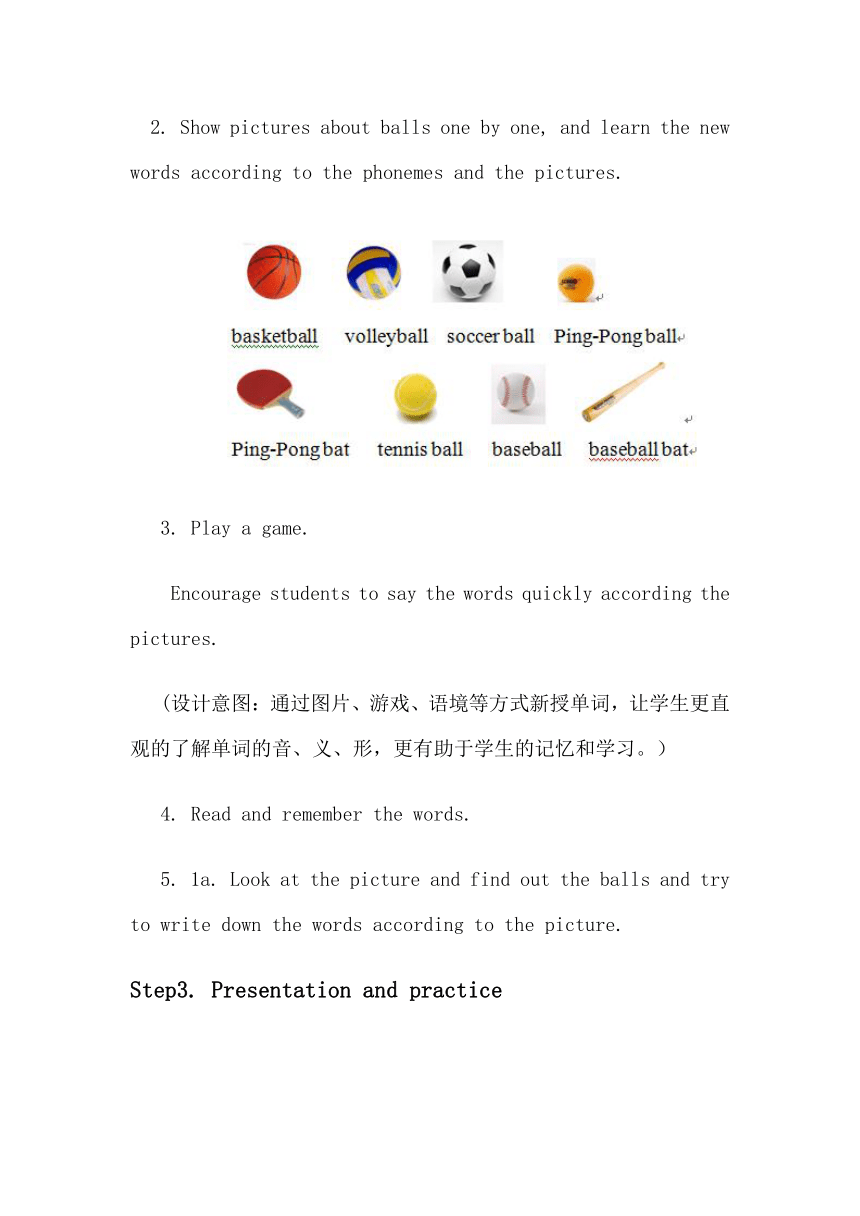
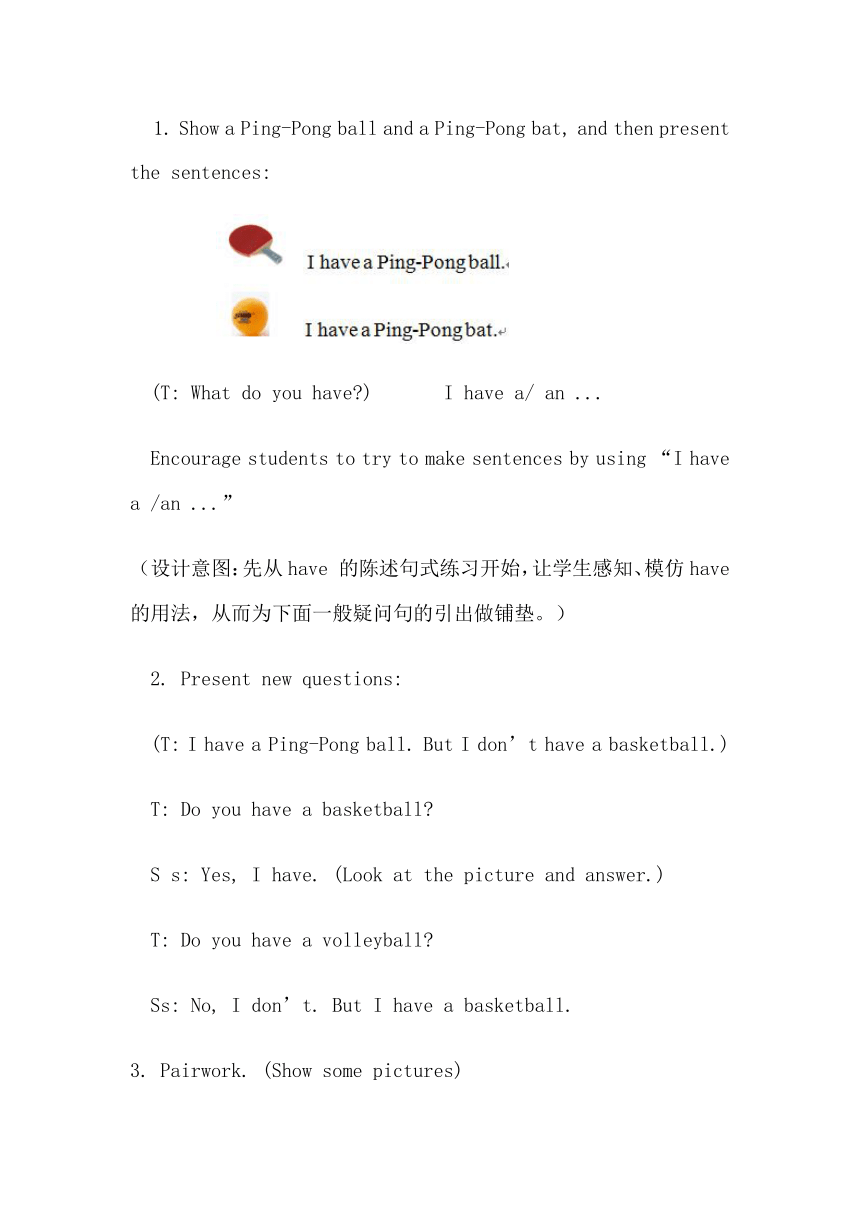
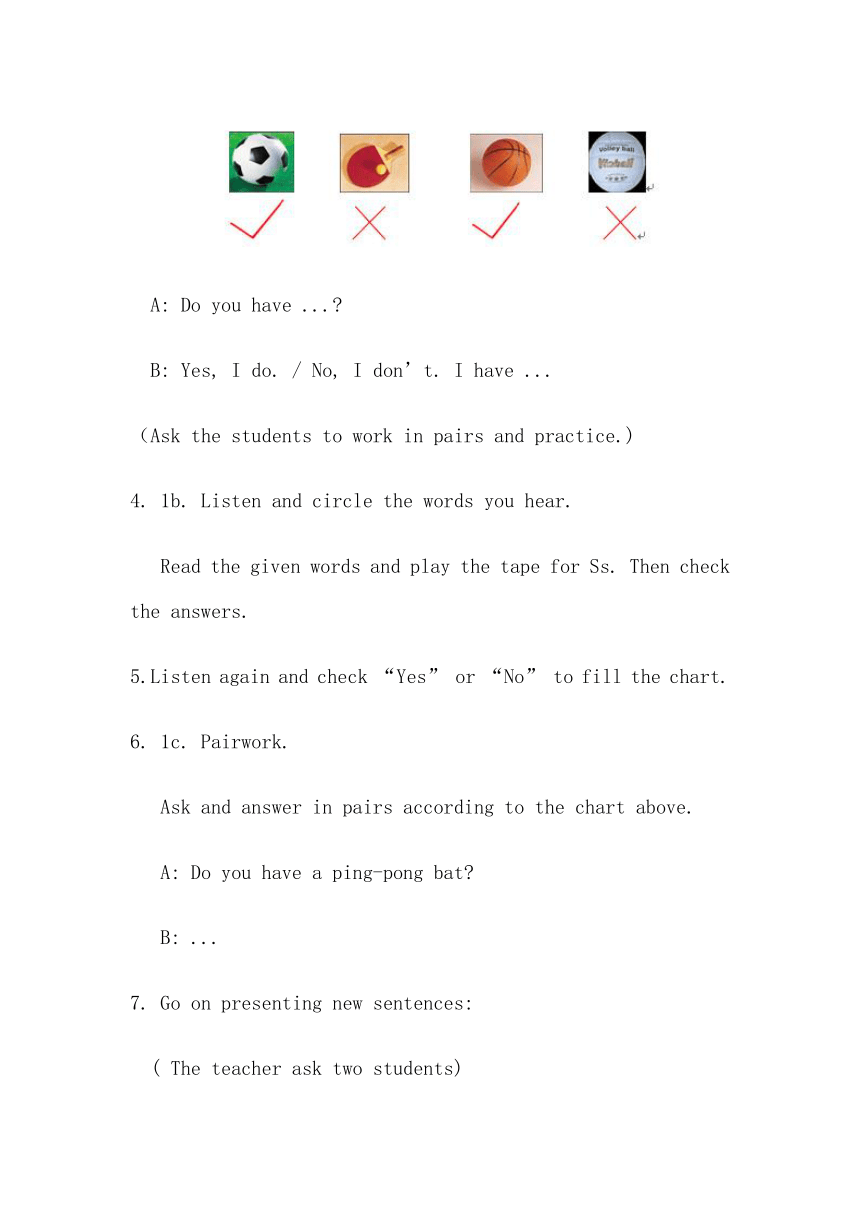
文档简介
Unit5
Do
you
have
a
soccer
ball
Section
A
(1a-2c)
Ⅰ.Teaching
aims:
1.
Knowledge
aims:
1).
New
words:
bal
( http: / / www.21cnjy.com )l,
basketball,
volleyball,
soccer,
Ping-Pong,
tennis,
have,
do
(does).
2).
The
sentences:
( http: / / www.21cnjy.com )I
have
...
He/
She
has
...
Do
you
have
...
Yes,
I
do./
No,
I
don’t.
Does
he/she
have
...
Yes,
he/she
does.
No,
he/she
doesn’t.
Ⅱ.
Ability
aims:
1).
Students
can
use
The
Simple
Present
Tense
to
“have”.
2).
Students
can
us
( http: / / www.21cnjy.com )e
“Do
you
have
... ”
or
“Does
he/she
have... ”
to
ask
the
questions
and
answer
the
questions
in
short
to
talk
about
ownership.
Ⅲ.
Emotion
aims:
1).
Students
( http: / / www.21cnjy.com )
can
know
about
many
kinds
of
sports
games
at
home
and
abroad.
2).
Students
can
enjoy
time
with
friends
while
playing
sports.
Ⅱ.
Teaching
importance
and
difficulties
1.
Practice
listening
and
speaking
skills.
2.
How
to
talk
about
the
ownership.
Ⅲ.
Teaching
procedures.
Step1.
Warming-up
1.
Enjoy
an
English
song
about
balls.
Encourage
students
to
try
to
sing
along
with
the
song.
2.
Enjoy
a
video
( http: / / www.21cnjy.com )with
a
question
“What
balls
can
you
see
in
the
video ”
(设计意图:以和球有关的歌曲开头,
( http: / / www.21cnjy.com )让学生在一种轻松的氛围中快速进入和本节课相关的学习思考当中。带着问题看视频,为新学知识做好铺垫,巧妙切入。)
Step2.
Learning
new
words
1.
Encourage
stu
( http: / / www.21cnjy.com )dents
to
try
to
say
what
balls
they
can
see
in
the
video.
2.
Show
pictures
abou
( http: / / www.21cnjy.com )t
balls
one
by
one,
and
learn
the
new
words
according
to
the
phonemes
and
the
pictures.
3.
Play
a
game.
Encourage
stu
( http: / / www.21cnjy.com )dents
to
say
the
words
quickly
according
the
pictures.
(设计意图:通过图片、游戏、语境等方式新授单词,让学生更直观的了解单词的音、义、形,更有助于学生的记忆和学习。)
4.
Read
and
remember
the
words.
5.
1a.
Loo
( http: / / www.21cnjy.com )k
at
the
picture
and
find
out
the
balls
and
try
to
write
down
the
words
according
to
the
picture.
Step3.
Presentation
and
practice
1.
Show
a
Ping-Pon
( http: / / www.21cnjy.com )g
ball
and
a
Ping-Pong
bat,
and
then
present
the
sentences:
(T:
What
do
you
have )
I
have
a/
an
...
Encourage
students
( http: / / www.21cnjy.com )
to
try
to
make
sentences
by
using
“I
have
a
/an
...”
(设计意图:先从have
的陈述句式练习开始,让学生感知、模仿have
的用法,从而为下面一般疑问句的引出做铺垫。)
2.
Present
new
questions:
(T:
I
have
a
Ping-Pong
ball.
But
I
don’t
have
a
basketball.)
T:
Do
you
have
a
basketball
S
s:
Yes,
I
have.
(Look
at
the
picture
and
answer.)
T:
Do
you
have
a
volleyball
Ss:
No,
I
don’t.
But
I
have
a
basketball.
3.
Pairwork.
(Show
some
pictures)
A:
Do
you
have
...
B:
Yes,
I
do.
/
No,
I
don’t.
I
have
...
(Ask
the
students
to
work
in
pairs
and
practice.)
4.
1b.
Listen
and
circle
the
words
you
hear.
Read
the
given
( http: / / www.21cnjy.com )words
and
play
the
tape
for
Ss.
Then
check
the
answers.
5.Listen
again
and
check
“Yes”
or
“No”
to
fill
the
chart.
6.
1c.
Pairwork.
Ask
and
answer
in
pairs
according
to
the
chart
above.
A:
Do
you
have
a
ping-pong
bat
B:
...
7.
Go
on
presenting
new
sentences:
(
The
teacher
ask
two
students)
T:
Do
you
have
a
basketball
S1:
Yes,
I
do.
T:
He
has
a
basketball.
(To
all
the
students)
T:
Do
you
have
a
volleyball
S2:
Yes,
I
do.
T:
She
has
a
volleyball.
(T:
What
does
your
friend
have )
He/
She
has
a
/an
...
(Encourage
Ss
to
try
to
make
sentences
by
using
:He/
She
has
...)
(设计意图:教师设计恰当的语境,目的是从have的第一人称的练习自然过渡到第三人称的练习。)
8.
Present
new
questions.
T:
Do
you
have
a
ping-pong
ball
S1:
Yes,
I
do.
T:
Do
you
have
a
basketball
S1:
No,
I
don’t.
T:
Does
she
have
a
ping-pong
ball
Ss:
Yes,
she
does.
T:
Does
she
have
a
basketball
Ss:
No,
she
doesn’t.
9.
Show
a
picture
and
practice
the
new
sentences.
A:
Does
Mike
have
a
basketball
B:
Yes,
he
does.
A:
Does
he
have
a
volleyball
B:
No,
he
doesn’t.
But
he
has
basketball.
10.
Groupwork.
A:
Do
you
have
...?
B:
Yes,
.../
No,
...
A:
Does
he/
she
have
...
C:
Yes,
he/she
does./
No,
he/she
doesn’t.
But
he
/she
has
...
Step
4
Consolidation.
1.
2a.
Talk
about
the
pictures.
2.Listen
to
the
tap
( http: / / www.21cnjy.com )e
and
number
the
pictures.
Then
check
the
answers.
3.
2b.
Listen
again
and
match
the
pictures
of
2a
with
the
balls.
Before
listening
( http: / / www.21cnjy.com ),
get
students
to
say
what
balls
they
can
see.
Then
play
the
tape.
After
the
listening
,
check
the
answers.
4.
Listen
again
and
check
“has”
or
“doesn’t
have”.
Names
Balls
Has/
Doesn’t
have
Who
Paul
soccer
ball
has
/
doesn’t
have
Bob/
Paul’s
brother
Mike
basketball
has
/
doesn’t
have
Jane
tennis
ball
has
/
doesn’t
have
Dale
volleyball
has
/doesn’t
have
Frank/
Dale’s
brother
5.
Listen
to
conversations
1
and
4,
then
circle
the
names.
Who
has
the
ball
(设计意图:此处两个环节,在2a,
2
( http: / / www.21cnjy.com )b两听的基础上,设计了三听、四听,目的是训练学生对听力材料细节的进一步把握,同时为下一环节2c
Pairwork的练习活动提供对话练习材料。)
6.
2c.
Pairwork
( http: / / www.21cnjy.com ).
(Get
Ss
to
work
in
pairs
and
make
conversations
like
the
model
according
to
the
chart
above.
)
Model:
A:
Does
Jane
have
a
tennis
ball
B:
No,
she
doesn’t.
A:
Does
...
have
....
B:Yes,
...
/
No,
...
But
...
Has...
7.
Read
the
listening
materials
and
find
out
the
language
chunks.
Let’s
play
tennis.
Let’s
go
and
find
him.
Step
5.
Summary.
Talk
about
ownership
I
have
...
He/
She
has
...
Do
you
have
...
Yes,
I
do./
No,
I
don't.
Does
he/she
( http: / / www.21cnjy.com )
have
...
Yes,
he/she
does.
No,
he
/she
doesn't.
Balls:
basketball,
volleyball,
...
Step6.
Make
a
survey.
Make
a
survey
in
you
( http: / / www.21cnjy.com )r
group:
What
balls
do
you
have
Then
give
a
report.
Names
Sports
things
I
Ping-pong
ball,
...
My
friend
Ask
and
answer
like
this:
A:
Do
you
have
a
...
B:
Yes,
...
/
No,
...
(设计意图:
通过小组调查讨
( http: / / www.21cnjy.com )论,让所有的学生参与到学习中来,培养学生独立思考和表达的能力。同时进行一个当堂语言知识的输出,真正达到学以致用,进一步理解运用所学的知识的目的。)
Report:
Hello!
I'm
...
I
ha
( http: / / www.21cnjy.com )ve
a
_________________________________________
I
have
a
friend.
Hi
( http: / / www.21cnjy.com )s/
Her
name
is
...
He/
She
has
___________________
________________________________________________________
________________________________________________________________________________________________________________
Step
7
Homework
Preview
and
read
2d.
(Try
to
recite)
Do
you
have
a
soccer
ball
Section
A
(1a-2c)
Ⅰ.Teaching
aims:
1.
Knowledge
aims:
1).
New
words:
bal
( http: / / www.21cnjy.com )l,
basketball,
volleyball,
soccer,
Ping-Pong,
tennis,
have,
do
(does).
2).
The
sentences:
( http: / / www.21cnjy.com )I
have
...
He/
She
has
...
Do
you
have
...
Yes,
I
do./
No,
I
don’t.
Does
he/she
have
...
Yes,
he/she
does.
No,
he/she
doesn’t.
Ⅱ.
Ability
aims:
1).
Students
can
use
The
Simple
Present
Tense
to
“have”.
2).
Students
can
us
( http: / / www.21cnjy.com )e
“Do
you
have
... ”
or
“Does
he/she
have... ”
to
ask
the
questions
and
answer
the
questions
in
short
to
talk
about
ownership.
Ⅲ.
Emotion
aims:
1).
Students
( http: / / www.21cnjy.com )
can
know
about
many
kinds
of
sports
games
at
home
and
abroad.
2).
Students
can
enjoy
time
with
friends
while
playing
sports.
Ⅱ.
Teaching
importance
and
difficulties
1.
Practice
listening
and
speaking
skills.
2.
How
to
talk
about
the
ownership.
Ⅲ.
Teaching
procedures.
Step1.
Warming-up
1.
Enjoy
an
English
song
about
balls.
Encourage
students
to
try
to
sing
along
with
the
song.
2.
Enjoy
a
video
( http: / / www.21cnjy.com )with
a
question
“What
balls
can
you
see
in
the
video ”
(设计意图:以和球有关的歌曲开头,
( http: / / www.21cnjy.com )让学生在一种轻松的氛围中快速进入和本节课相关的学习思考当中。带着问题看视频,为新学知识做好铺垫,巧妙切入。)
Step2.
Learning
new
words
1.
Encourage
stu
( http: / / www.21cnjy.com )dents
to
try
to
say
what
balls
they
can
see
in
the
video.
2.
Show
pictures
abou
( http: / / www.21cnjy.com )t
balls
one
by
one,
and
learn
the
new
words
according
to
the
phonemes
and
the
pictures.
3.
Play
a
game.
Encourage
stu
( http: / / www.21cnjy.com )dents
to
say
the
words
quickly
according
the
pictures.
(设计意图:通过图片、游戏、语境等方式新授单词,让学生更直观的了解单词的音、义、形,更有助于学生的记忆和学习。)
4.
Read
and
remember
the
words.
5.
1a.
Loo
( http: / / www.21cnjy.com )k
at
the
picture
and
find
out
the
balls
and
try
to
write
down
the
words
according
to
the
picture.
Step3.
Presentation
and
practice
1.
Show
a
Ping-Pon
( http: / / www.21cnjy.com )g
ball
and
a
Ping-Pong
bat,
and
then
present
the
sentences:
(T:
What
do
you
have )
I
have
a/
an
...
Encourage
students
( http: / / www.21cnjy.com )
to
try
to
make
sentences
by
using
“I
have
a
/an
...”
(设计意图:先从have
的陈述句式练习开始,让学生感知、模仿have
的用法,从而为下面一般疑问句的引出做铺垫。)
2.
Present
new
questions:
(T:
I
have
a
Ping-Pong
ball.
But
I
don’t
have
a
basketball.)
T:
Do
you
have
a
basketball
S
s:
Yes,
I
have.
(Look
at
the
picture
and
answer.)
T:
Do
you
have
a
volleyball
Ss:
No,
I
don’t.
But
I
have
a
basketball.
3.
Pairwork.
(Show
some
pictures)
A:
Do
you
have
...
B:
Yes,
I
do.
/
No,
I
don’t.
I
have
...
(Ask
the
students
to
work
in
pairs
and
practice.)
4.
1b.
Listen
and
circle
the
words
you
hear.
Read
the
given
( http: / / www.21cnjy.com )words
and
play
the
tape
for
Ss.
Then
check
the
answers.
5.Listen
again
and
check
“Yes”
or
“No”
to
fill
the
chart.
6.
1c.
Pairwork.
Ask
and
answer
in
pairs
according
to
the
chart
above.
A:
Do
you
have
a
ping-pong
bat
B:
...
7.
Go
on
presenting
new
sentences:
(
The
teacher
ask
two
students)
T:
Do
you
have
a
basketball
S1:
Yes,
I
do.
T:
He
has
a
basketball.
(To
all
the
students)
T:
Do
you
have
a
volleyball
S2:
Yes,
I
do.
T:
She
has
a
volleyball.
(T:
What
does
your
friend
have )
He/
She
has
a
/an
...
(Encourage
Ss
to
try
to
make
sentences
by
using
:He/
She
has
...)
(设计意图:教师设计恰当的语境,目的是从have的第一人称的练习自然过渡到第三人称的练习。)
8.
Present
new
questions.
T:
Do
you
have
a
ping-pong
ball
S1:
Yes,
I
do.
T:
Do
you
have
a
basketball
S1:
No,
I
don’t.
T:
Does
she
have
a
ping-pong
ball
Ss:
Yes,
she
does.
T:
Does
she
have
a
basketball
Ss:
No,
she
doesn’t.
9.
Show
a
picture
and
practice
the
new
sentences.
A:
Does
Mike
have
a
basketball
B:
Yes,
he
does.
A:
Does
he
have
a
volleyball
B:
No,
he
doesn’t.
But
he
has
basketball.
10.
Groupwork.
A:
Do
you
have
...?
B:
Yes,
.../
No,
...
A:
Does
he/
she
have
...
C:
Yes,
he/she
does./
No,
he/she
doesn’t.
But
he
/she
has
...
Step
4
Consolidation.
1.
2a.
Talk
about
the
pictures.
2.Listen
to
the
tap
( http: / / www.21cnjy.com )e
and
number
the
pictures.
Then
check
the
answers.
3.
2b.
Listen
again
and
match
the
pictures
of
2a
with
the
balls.
Before
listening
( http: / / www.21cnjy.com ),
get
students
to
say
what
balls
they
can
see.
Then
play
the
tape.
After
the
listening
,
check
the
answers.
4.
Listen
again
and
check
“has”
or
“doesn’t
have”.
Names
Balls
Has/
Doesn’t
have
Who
Paul
soccer
ball
has
/
doesn’t
have
Bob/
Paul’s
brother
Mike
basketball
has
/
doesn’t
have
Jane
tennis
ball
has
/
doesn’t
have
Dale
volleyball
has
/doesn’t
have
Frank/
Dale’s
brother
5.
Listen
to
conversations
1
and
4,
then
circle
the
names.
Who
has
the
ball
(设计意图:此处两个环节,在2a,
2
( http: / / www.21cnjy.com )b两听的基础上,设计了三听、四听,目的是训练学生对听力材料细节的进一步把握,同时为下一环节2c
Pairwork的练习活动提供对话练习材料。)
6.
2c.
Pairwork
( http: / / www.21cnjy.com ).
(Get
Ss
to
work
in
pairs
and
make
conversations
like
the
model
according
to
the
chart
above.
)
Model:
A:
Does
Jane
have
a
tennis
ball
B:
No,
she
doesn’t.
A:
Does
...
have
....
B:Yes,
...
/
No,
...
But
...
Has...
7.
Read
the
listening
materials
and
find
out
the
language
chunks.
Let’s
play
tennis.
Let’s
go
and
find
him.
Step
5.
Summary.
Talk
about
ownership
I
have
...
He/
She
has
...
Do
you
have
...
Yes,
I
do./
No,
I
don't.
Does
he/she
( http: / / www.21cnjy.com )
have
...
Yes,
he/she
does.
No,
he
/she
doesn't.
Balls:
basketball,
volleyball,
...
Step6.
Make
a
survey.
Make
a
survey
in
you
( http: / / www.21cnjy.com )r
group:
What
balls
do
you
have
Then
give
a
report.
Names
Sports
things
I
Ping-pong
ball,
...
My
friend
Ask
and
answer
like
this:
A:
Do
you
have
a
...
B:
Yes,
...
/
No,
...
(设计意图:
通过小组调查讨
( http: / / www.21cnjy.com )论,让所有的学生参与到学习中来,培养学生独立思考和表达的能力。同时进行一个当堂语言知识的输出,真正达到学以致用,进一步理解运用所学的知识的目的。)
Report:
Hello!
I'm
...
I
ha
( http: / / www.21cnjy.com )ve
a
_________________________________________
I
have
a
friend.
Hi
( http: / / www.21cnjy.com )s/
Her
name
is
...
He/
She
has
___________________
________________________________________________________
________________________________________________________________________________________________________________
Step
7
Homework
Preview
and
read
2d.
(Try
to
recite)
同课章节目录
- starters 预备篇(2012秋审查)
- Unit 1 Good morning !
- Unit 2 What’s this in English?
- Unit 3 What color is it ?
- Unit 1 My name's Gina.
- Section A
- Section B
- Unit 2 This is my sister.
- Section A
- Section B
- Unit 3 Is this your pencil?
- Section A
- Section B
- Unit 4 Where's my schoolbag?
- Section A
- Section B
- Unit 5 Do you have a soccer ball?
- Section A
- Section B
- Unit 6 Do you like bananas?
- Section A
- Section B
- Unit 7 How much are these socks?
- Section A
- Section B
- Unit 8 When is your birthday?
- Section A
- Section B
- Unit 9 My favorite subject is science.
- Section A
- Section B
